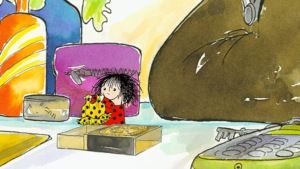Business & Education
The subversive menace that got one of Cirkeline’s episodes banned
This article is more than 9 years old.
Richard Nixon and General Franco among the targets of the socialist creators

I have heard that Franco likes to flamenco! (stock photo)
The nation’s favourite animated matchgirl Cirkeline has been entertaining kids for nearly five decades, but don’t let her sweet exterior fool you. The little scamp and her mouse friends hide a radical past that national broadcasting network DR found all too much. With its childlike drawings, primitive animation techniques and political irreverence, Cirkeline is this country’s answer to ‘South Park’.
Like Dogme in the 1960s
The character of Cirkeline, the wild-haired, fearless little girl in a red and black polka dot dress who lives in a matchbox, was created in 1957 by art student Hanne Hastrup, who was responsible for both the drawings and manuscripts.
However, she did not appear on television until 1968 in an episode entitled ‘Frederik’s Birthday’ – the partial result of Hanne’s marriage to Jannik Hastrup, the animator and producer of the series, who needed a character for a film he was working on and found one closer to home than he would have imagined.
Seeing them now, in the age of computer graphics, the style appears primitive to say the least: Hanne Hastrup has described the old animation techniques of the time as so bad that the couple made “Dogme films in the ‘60s”.
In all just 19 films were made in the Cirkeline series, of which six are in black and white and 12 are in colour. There have also been three full-length feature films: ‘City Mice’ (1998), ‘Mice and Romance’ (Ost og Kærlighed, 2000) and ‘Little Big Mouse’ (Cirkeline og verdens mindste superhelt, 2004).
Socialism on tap
The original series can still be seen on the DR channels. However, the last episode of the series, ‘Fleeing from America’ in 1971 (see below), has never been aired by the national broadcaster.
Jannik Hastrup’s socialist viewpoints were no secret and the fabulous adventures of Cirkeline and her rodent compadres Frederik and Ingolf can often be read as a political critique of right-wing regimes, subtexts which more than once led the husband-and-wife team into hot water with the network.
In one episode, for example, the adventurers found themselves in Spain, where they met a rather unpleasant cat by the name of Franco, which was ordered to be changed by the Hastrups’ superiors to ‘Mogens’.
Cirkeline meets the Black Panthers
The episode ‘Fleeing from America’ finally broke the camel’s back as far as DR was concerned. It judged it too disturbing and satirically political for children. A series that began so charmingly in 1968 with ‘Frederik’s Birthday’ had evolved radically into a scathing attack on the USA and President Richard Nixon’s interior policies.
In the episode in question, Cirkeline and her chums enjoy a game of trains, and during a round-the-world trip arrive in America where they meet the military police and a black mouse who is a member of the Black Panthers. This mouse, who we never actually get to see, tells us of racial hatred and the persecution of black people in his country.
The character Little Brother then disappears in the big city, and Cirkeline and Frederik ally with some Native American Indians to try and find him. The soldiers open fire at the Indians, Frederik and Cirkeline – but luckily they are only toy soldiers made out of plastic the heroes can simply push over, and it’s only a game after all.
It sent broadcasters fleeing
During the film, disturbing photos and symbols are cut and pasted into the animation, and at the end, when it is clear it is all just a game, the figures appear in front of a book on the artist’s drawing board, where the ‘X’ in Nixon has been made into a swastika, leaving the (mature) viewer in no doubt as to the message being communicated.
The State’s Filmcentral and Pilot Film, the distributor of the Cirkeline cartoons, chose to distance itself from the film just as DR had. ‘Fleeing from America’ was instead shown through ‘Kinok’, a company founded by the Danish Vietnam Committee, which specialised in the distribution of political and anti-imperialist films.
Having managed to survive into the new century, Cirkeline now has her own line of merchandise for those girls looking for a role model other than Barbie. And that’s fine with national TV – just don’t mention her time in the US!










































